See Insights in Action
By embracing DemandJump's approach to SEO, we have been able to increase our organic rankings within just 2 weeks of implementing recommendations. This helped us see a 22% increase in organic search month-over-month.
Robert Jacko Vice President Digital Marketing @ Homage
DemandJump has become a crucial extension of our marketing team, providing game changing insights to fuel and propel all aspects of our digital marketing efforts. The DemandJump platform is a must have, we are seriously impressed.
Tim Lavinder Director of Ecommerce @ Hotsox
We used to spend hours looking for insights in dozens of tools and reports. Now we log into one place to find out what customers are doing and how to meet them where it matters most.
Zach Roop Digital Marketing Manager @ Dometic
We use DemandJump recommendations as our digital to-do list. We love going in and seeing the recommendations and knowing what to do next.
JoLynda Wilson Marketing Director @ IWC
Trusted by Brands Around the World
Consumer Insights
Find out what your target audience cares about for any category, product, or topic, with the click of a button.
Know What to Write About
Eliminate the guesswork and align your content strategy to actual user behavior.
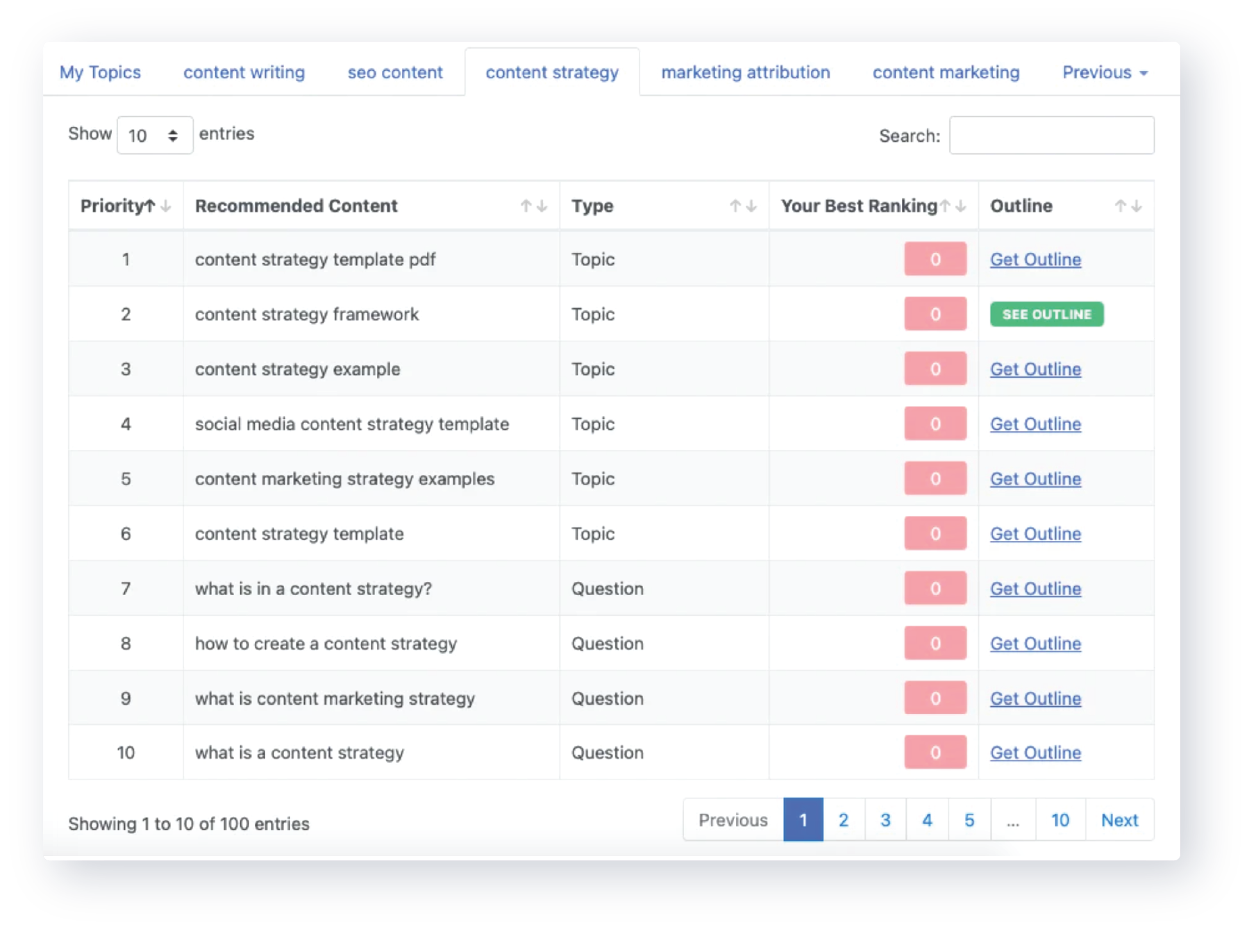
Know Which Keywords Matter
Get a prioritized list of the exact keywords that matter for your audience.
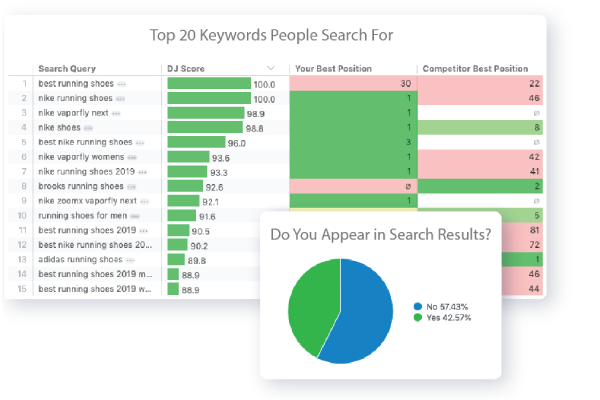
Automatic Customer Journey Map
Automated customer journey mapping tells you the keywords, questions, websites and videos your audience consumes for each stage of the buying process.
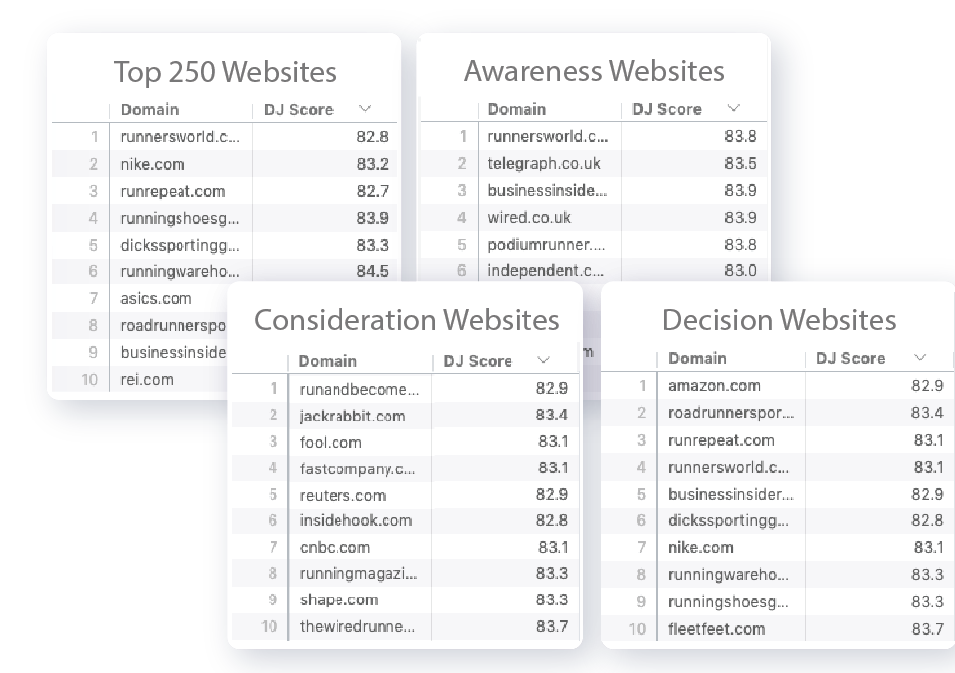
Get Free Consumer Insights Now
What are the 7 types of consumers?
It's hard to overstate the importance of consumer behavior to marketing. Of course, all customers don't make purchase decisions for the same reasons or even follow a similar process when they shop. However, consumer insights can show how or why consumers buy so you can align to their preferences and increase their chances of buying.
People's personalities and budgets factor into their choices as well. Equally important, specific kinds of purchases and even moods all can influence customer behavior. Take some time to explore the many factors influencing consumer behavior and how to use this information to improve your bottom line.
What is a consumer?
Before exploring various kinds of consumers, it will help to clearly define what the term consumer means. According to a typical dictionary, a consumer can refer to anybody who uses products or services. A more marketing-based definition of consumer would tend to regard consumers as people who either purchase goods or services for themselves or for others.
For instance, a parent may buy groceries for themselves and for other people in their family. Thus, you might need to sometimes target people who buy products that they aren't necessarily going to use for themselves.
In other words, most marketers tend to think of consumers as either customers or potential customers. Very often, they might focus upon only those consumers who have already purchased from their business or who are likely to have an interest in purchasing from them in the future. In that case, they might use consumers to refer only to their target audience and not all potential consumers.
What motivates consumer behavior?
Marketers want to know what motivates customers to make purchases in order to appeal to these motivations with advertising and brand-building to bring in new customers. With that in mind, these are the general motivation factors influencing consumer behavior:
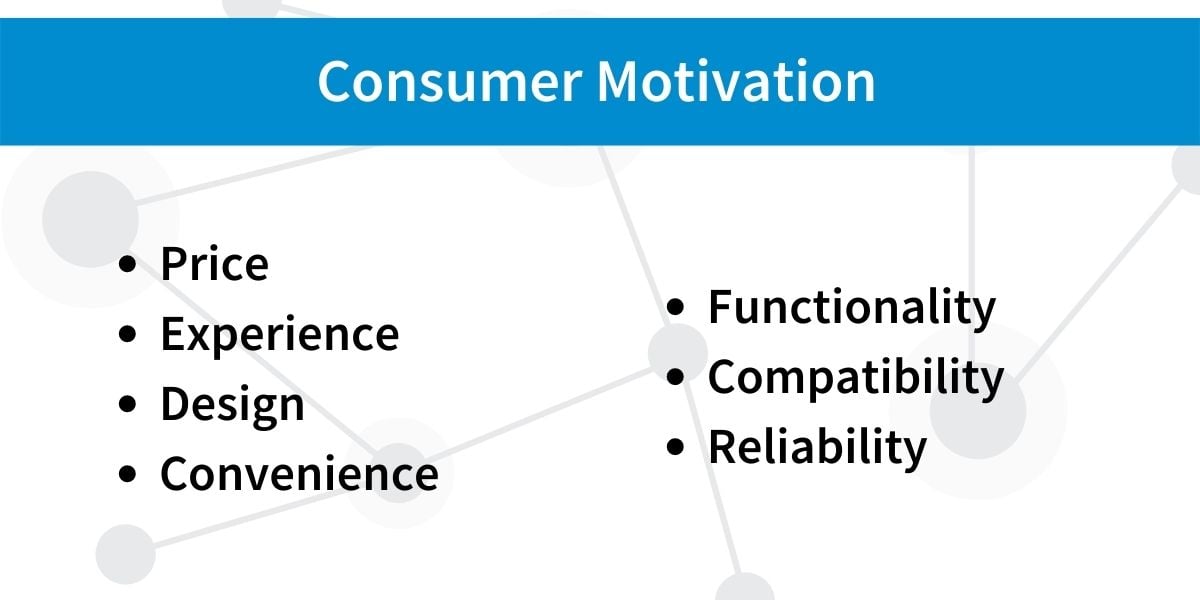
Price
Even if some consumers don't consider price the most important part of their buying decision, the majority will care about the cost to some degree. For many purchases, people will weigh the price against other factors to ensure they get a good value.
Experience
Customer experience has become an important marketing topic these days. Some customers may value personal service while comparing purchases, but others may just look for such simple options as online ordering and getting reliable deliveries. Others might care about the way they're treated after the sale.
Design
Customers generally gravitate towards products that they find appealing. If certain products all look pretty much alike, brands might still differentiate themselves through packaging design.
Convenience
Busy people might mostly care about finding accessible and convenient purchasing options. They may want to order online and have a choice of delivery methods and even in-store pickup options.
Functionality
Obviously, customers will expect the product or service to do what they want it to do. Purchases should work as intended and advertised.
Compatibility
Some consumers may have concerns that their purchase will work well with other things they already have. For example, cell phones might use micro-USB or type-C charging cables. If a consumer has an Apple phone, they may tend to consider an iPad or Mac computer over a Windows or Chrome device for compatibility.
Reliability
Customers would generally want to know that they can count on the purchase to keep working and remain durable. They may pay more for brands that have earned a reputation for reliability and offer warranties to help ensure satisfaction.
What is an example of complex consumer motivations?
While you can understand some aspects of buying behavior by considering motivations, keep in mind that customers may balance multiple concerns at the same time. For example, consumers may care somewhat about price and also want to make sure they spend their money on reliable and functional products. Customers won't always just want to buy the cheapest thing but the product that will offer them the best value.
You can find good consumer behavior examples of this when you study the pet food industry. According to a study published on the National Institute of Health, most pet owners tend to care about price and quality about equally, though some consider one factor more important than the other. Since changing pet food usually takes a transitional period, pet owners also tend to become loyal to certain brands. If a pet owner finds their purchase affordable and a dog or cat appears to remain healthy and enjoy the food, they'll probably stick with a brand unless motivated to change.
What are definitions of the 7 types of consumers?
Beyond motivation, marketers also group consumers into various types. Customers may fall into these different groups because of motivation, circumstances, marketing they've seen, and often, previous experience with a company. Thus, you use various characteristics of consumer behavior to separate out these 7 types of consumers.
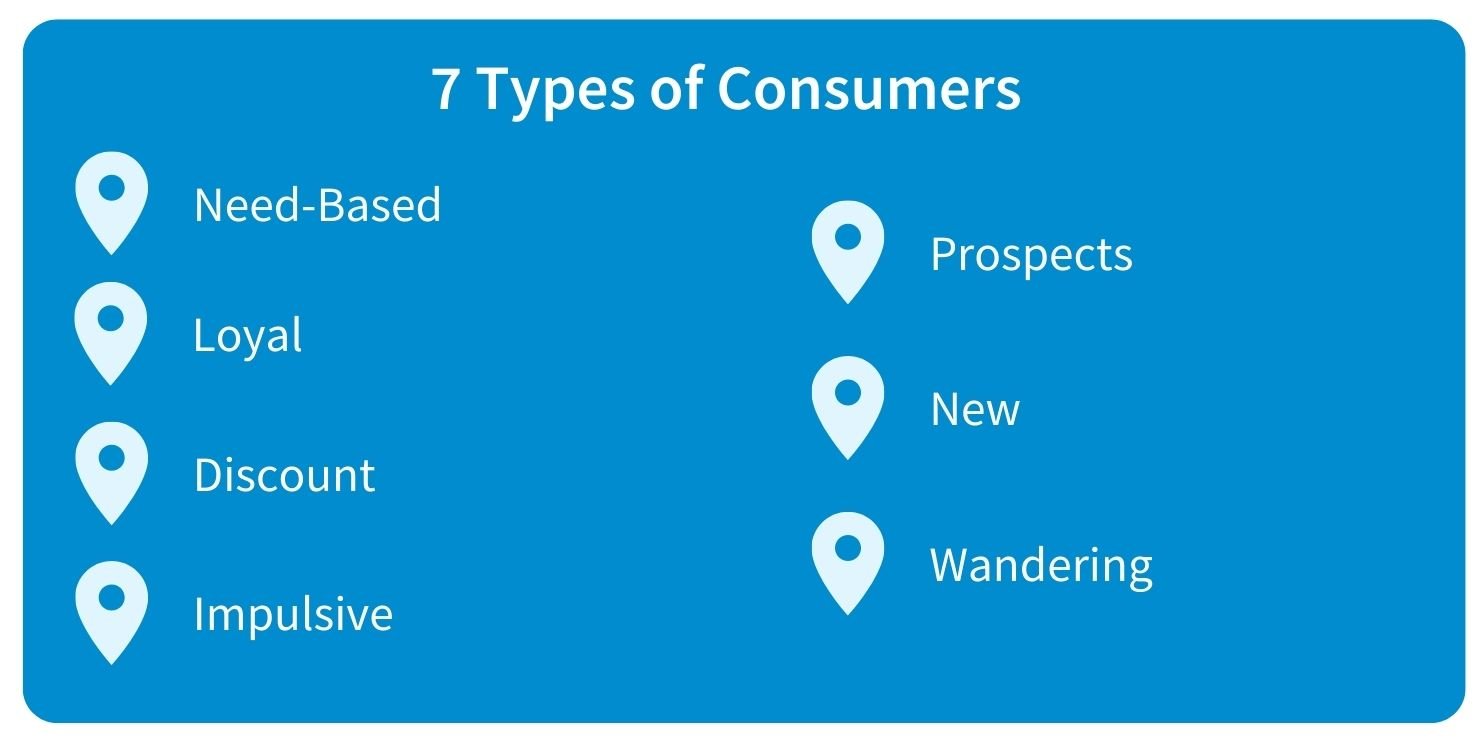
Need-based
These people tend to make shopping lists and only purchase what they need. They typically don't expect to need much help and know a lot about the product they intend to purchase. Businesses may differentiate themselves with these customers by promoting some exceptional quality or lower prices.
Loyal
Some customers demonstrate loyalty to a brand. Very often, these loyal customers provide companies with the most revenue and profits. Businesses can court and maintain this loyalty by offering loyalty programs. Also, surveys can reassure these customers that the company values their opinions and wants to keep them satisfied. Most marketers would suggest that investments in loyal customers tend to provide good returns.
Discount
These consumers want to find special sales and would seldom choose the name brand when the store brand will do. In general, it's difficult to turn discount customers into loyal customers. They're likely to respond well to sales, coupons, and promotions. If discount customers know they can count on your brand for lower prices or the best value, they may demonstrate some loyalty.
Impulsive
Impulsive customers may not react so much to any of the typical buying characteristics as they do to their own mood. They may respond best to brief assistance and perhaps, unique and appealing packaging or product design. Some brands work to stimulate a buying mood. Some simple examples might include the upbeat music playing in a store or even the color scheme used on packaging or a website.
Prospects
Prospects refer to potential customers who have not purchased anything yet. They may eventually turn into new or loyal customers. For instance, prospects may indicate their interest by filling out a lead form, visiting a website, or entering a physical store. You may encourage these prospects to buy by giving them more information about your products and your business.
New
A new customer has just made their first purchase. At this critical time, a business needs to impress the customer with the quality of their offerings and their customer service. In some cases, businesses should also use this time to make certain the customer understands how to make the best use of their purchase.
Wandering customers
This describes the kind of customers who enjoy browsing around. The ambiance of a store or website may have attracted them. As with other potential customers, engaging them with information about products and services may convert them, but you'll probably find them tougher to convert than customers who have indicated specific interests in your products or services.
What are the types of consumer buying behavior?
Marketers might also make distinctions between different types of consumer buying behavior. The kind of products or where the consumer sits in the consumer buying process may influence their buying behavior. As an example of factors influencing consumer buying behavior, people may put more thought into purchasing a new home than a new toaster.
Even the toaster buyer might spend some time researching such features as settings, slot width, and so on. In addition, customers might compare prices and reviews to see which product will offer them the best reliability and functionality for the lowest cost. Some will care about toaster design because they will want an appliance that complements their kitchen decor.
Once a toaster buyer has gathered the information that they care about, they may proceed to make a fairly quick choice between various models and brands. On the other hand, people buying cars, boats, or homes will probably still spend more time deliberating and comparing options.
What are the four types of buying behavior?
Marketers generally define four kinds of typical buyer behavior.
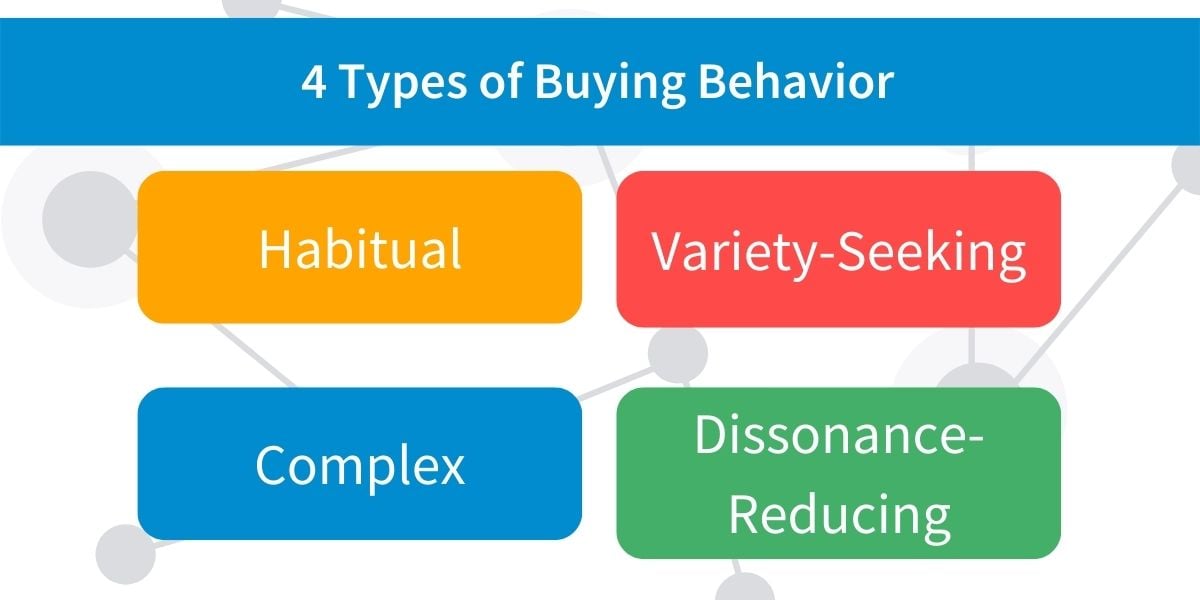
Habitual buying behavior
When consumers make routine and fairly low-risk purchases, they may engage in habitual buying behavior. They might choose a favorite brand or simply see what's on sale that day. Some examples of these sorts of products could include paper towels, seasonings, butter, coffee, and eggs.
Since habitual buyers may respond to price, discounts, sales, and coupons can influence them. To keep them loyal to a brand, it's a good idea to use visual cues on packaging, like brand logos or mascots.
Variety-seeking buying behavior
Variety-seeking behavior sounds like the opposite of habitual buying behavior, but that's not exactly true. Some consumers may seek variety in their fairly routine purchases to see if they experience some beneficial difference or as the name implies, simply variety.
For example, the customer may have traditionally purchased medium-roast instant coffee from the same brand. This person could see dark-roast instant coffee from another brand and decide to switch to find out if they like the taste better. Discounts and deals can also help influence variety seekers. Also, because of this kind of behavior, many manufacturers offer multiple varieties of the same type of product.
Complex buying behavior
Typically, customers will exhibit complex buying behavior when they make expensive, important, and high-risk purchases. For instance, you could expect a consumer to do more research and need more assistance when they're buying a new laptop or mobile phone than when they're purchasing a cheap calculator. In these cases, the consumer might research online, consult friends and family, and ask for more assistance from the retailer.
To help consumers make complex purchasing decisions, marketers need to provide plenty of information about their products and their brands. They should also underscore the benefits of purchasing from them instead of a competitor. Marketers also need to expect a longer buying process and ensure that they keep customers engaged with the business. After-sale service and engagement can help keep these customers loyal when they need to make their next important purchase.
Dissonance-reducing buying behavior
As with complex buying decisions, consumers might attach a lot of importance to their purchase when they engage in dissonance-reducing buying behavior. Very often, this describes choices that people make when they don't have many available choices, so they purchase products without researching them much. Some businesses can use this sort of behavior and products to attract new customers that will later convert to loyal consumers because they felt happy with their initial purchase.
As an example, some high-end mattress manufacturers and stores also sell the sort of air beds that people buy for overnight guests or camping. Only a few companies make these items, but a customer who feels satisfied with their first purchase of a $50 air bed might remember that brand when they want to buy a $1,000 mattress later.
Some companies may focus upon the products or services that tend to generate this sort of buying behavior to reduce competition. Other businesses use them to attract new customers to their brand. After-sale service, engagement, and promotional offers can help to retain these customers.
How do online marketers use types of consumer buying behavior to increase sales?
When marketers factor in motivations, stage in the buying process, and other factors influencing consumer behavior, it's obvious that the buyer journey can get complicated. In addition, digital marketers need a way to track behaviors, so they can better determine which steps in their marketing plans have worked well and which ones could use some tuning.
As an example, you might launch a display campaign that you run along with your normal paid search ads. You may see a surge of new website visitors and even customers from your search ads. However, you might not know if you should attribute some of this success to improved brand recognition or information from the display ads.
Using a data driven attribution model, you'll have a way to track behavior across your entire platform, including conversion source information. Even more, you can track this data for search campaigns, website traffic, and even visitors to a physical store, according to Google. With this conversion information, you can see which paths meet the digital marketing kpis that you've set to support your overall business goals.
Consumer behavior examples for data driven attribution models
To illustrate how data driven attribution models work, it will help to provide some consumer behavior examples.
Let's say that you sell tickets through your website for a dolphin tour in Galveston. You have ads triggered by both the keyphrases "Galveston boat tours" and "Galveston dolphin tours." Typical conversion tracking might tell you that your "Galveston dolphin tours" ad converts the best. Based on only this information, you might decide to remove the "Galveston boat tours" ad in order to invest more in the second advertisement. After that, you see that your conversions for the second ad drop mysteriously.
By adding data driven attribution models, you might also learn that your very best conversions come from tourists who click the "Galveston boat tours" advertisement before they finally click on your "Galveston dolphin tours" ad to make a purchase. Without a way to view multiple touchpoints and gain additional insight into a unique consumer behavior for your business, you might have considered dropping the low-performing advertisement and then suffered a drop in conversions. With this more complete picture, you know you should optimize your advertising by keeping both ads in place.
Insights Resources
Consumer InsightsConsumer Behavior
Consumer Behavior for Marketers
Consumer Insights and Analytics
Customer Insight Research Techniques
Customer Journey Map
Pillar Page Content
SEO Content Strategy
Types of Consumer Insights
Other Resources
Channel Optimization
Consumer Behavior
Consumer Insights
Consumer Insights and Analytics
Competitor Analysis Tools
Content Marketing
Content Strategy
Cross-Channel Analytics
Customer Insight Research Techniques
Customer Journey Map
Market Intelligence
Marketing Analytics Techniques
Market Research
Marketing Attribution
Opportunities of Internet Marketing
Types of Consumer Insights





